
The common buzzard is a medium-to-large bird of prey which has a large range. It is a member of the genus Buteo in the family Accipitridae. The species lives in most of Europe and extends its breeding range across much of the Palearctic as far as northwestern China, far western Siberia and northwestern Mongolia. Over much of its range, it is a year-round resident. However, buzzards from the colder parts of the Northern Hemisphere as well as those that breed in the eastern part of their range typically migrate south for the northern winter, many journeying as far as South Africa.

Kite is the common name for certain birds of prey in the family Accipitridae, particularly in subfamilies Milvinae, Elaninae, and Perninae. The term is derived from Old English cȳta, from the Proto-Indo-European root *gū- , "screech."

Buteo is a genus of medium to fairly large, wide-ranging raptors with a robust body and broad wings. In the Old World, members of this genus are called "buzzards", but "hawk" is used in the New World. As both terms are ambiguous, buteo is sometimes used instead, for example, by the Peregrine Fund.
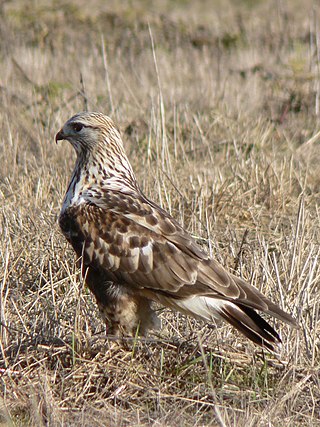
The rough-legged buzzard (Europe) or rough-legged hawk (Buteo lagopus) is a medium-large bird of prey. It is found in Arctic and Subarctic regions of North America, Europe, and Russia during the breeding season and migrates south for the winter. It was traditionally also known as the rough-legged falcon in such works as John James Audubon's The Birds of America.

The coscoroba swan is a species of waterfowl in the subfamily Anserinae of the family Anatidae. It is found in Argentina, Bolivia, Brazil, Chile, Paraguay, Uruguay, and the Falkland Islands.

The lizard buzzard or lizard hawk, is a bird of prey in the family Accipitridae. It is native to Sub-Saharan Africa. Despite its name, it may be more closely related to the Accipiter hawks than the Buteo buzzards.

The long-legged buzzard is a bird of prey found widely in several parts of Eurasia and in North Africa. This species ranges from Southeastern Europe down to East Africa to the northern part of the Indian subcontinent. The long-legged buzzard is a member of the genus Buteo, being one of the larger species therein. Despite being relatively powerful, it is considered a rather sluggish raptor overall. Like most buzzards, it prefers small mammals such as rodents, including gerbils, ground squirrels, voles and rats, also taking reptiles, birds and insects as well as carrion. Adaptable to a variety of habitats, long-legged buzzards may nest on a variety of surfaces, including rocks, cliffs and trees. it is a typical buzzard in its reproductive biology. The long-legged buzzard is widely distributed and appears to be quite stable in population. Therefore, it is considered as Least Concern by the IUCN.

The Cape Verde Islands dry forests is a tropical and subtropical dry broadleaf forests ecoregion in the Cape Verde Islands, which constitute the country of Cabo Verde. The islands lie off the western coast of Africa.

The great sparrow, also known as the southern rufous sparrow, is found in southern Africa in dry, wooded savannah and towns.
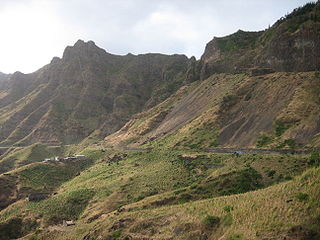
Serra Malagueta is a mountain range located in the northern part of the island of Santiago, Cape Verde. At 1064 m elevation, it is highest point of northern Santiago. The mountain range is protected as the Serra Malagueta Natural Park, that was established on February 24, 2005 and covers 774 hectares. The natural park is situated in the municipalities Tarrafal, São Miguel and Santa Catarina. The summit is in São Miguel, south of the Ribeira Principal valley. The Serra Malagueta formation is of volcanic origin, and was formed between 2.9 and 2.4 million years ago.
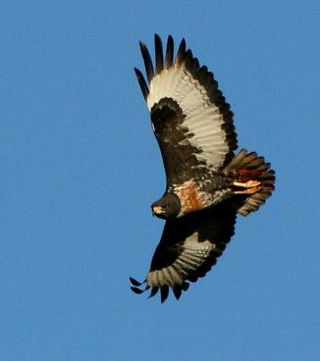
The jackal buzzard is a fairly large African bird of prey. The taxonomy of this species has caused some confusion in the past and it almost certainly belongs in a species complex with other African Buteo species. Some taxonomists have considered this species, the Archer's buzzard, and the augur buzzard to be the same superspecies. Many taxonomists consider them all to be distinct, having different calls, different home ranges and variations in plumage. This is a species that lives among mountains, and on adjacent savanna and grassland. It is resident and non-migratory throughout its range.

The augur buzzard is a fairly large African bird of prey. This species is distinct in typical adult plumage for its blackish back, whitish underside and orange-red tail, while juvenile augur buzzards are generally rather brown in colour; however a dark morph is known, which causes the bird's entire body to become darker. This member of the Buteo genus is distributed in several parts of the central and southern Africa, normally being found from Ethiopia to southern Angola and central Namibia. It is resident and non-migratory throughout its range. This is a species of mountains, and adjacent savannah and grassland. This is a typical buteonine raptor, being a generalist predator which tends to prefer small mammals supplemented by reptiles and birds among various prey items.

The upland buzzard is a species of bird of prey in the family Accipitridae. The largest species of the Buteo genus, this buzzard lives in mountainous grassy and rocky areas in areas of Central Asia, northern South Asia and East Asia from Kazakhstan to Korea. The upland buzzard is migratory but typically covers a short distance apparently to avoid snow cover that may hamper prey capture. This species primarily subsists on small mammals but does not shun alternate prey from small to large birds and insects. This little known raptor has a large range, and though generally uncommon, it is not thought to be rare or declining as a species. As a result it is classified as least concern by the IUCN.

The white-rumped hawk is a species of bird of prey in subfamily Accipitrinae, the "true" hawks, of family Accipitridae. It is found in Argentina, Bolivia, Brazil, Colombia, Ecuador, Paraguay, Peru, and Venezuela.

The Socotra buzzard is a medium to large bird of prey that is sometimes considered a subspecies of the widespread common buzzard. As its name implies, it is native to the island of Socotra, Yemen. Although it is listed as vulnerable in the IUCN Red List, its population is considered to be stable.
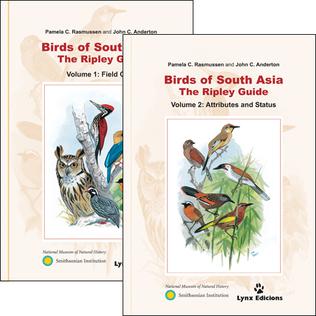
Birds of South Asia: The Ripley Guide by Pamela C. Rasmussen and John C. Anderton is a two-volume ornithological handbook, covering the birds of South Asia, published in 2005 by the Smithsonian Institution and Lynx Edicions. The geographical scope of the book covers India, Bangladesh, Pakistan, Sri Lanka, Nepal, Bhutan, Maldives, the Chagos Archipelago and Afghanistan. In total, 1508 species are covered. Two notable aspects of Birds of South Asia are its distribution evidence-base — the book's authors based their distributional information almost completely on museum specimens — and its taxonomic approach, involving a large number of species-level splits.
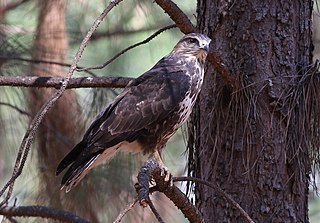
The forest buzzard, is a species of bird of prey found in Africa, though some authorities have placed it as a subspecies of another species, the mountain buzzard, Buto oreophilus. This is a resident breeding species in woodlands in southern and eastern South Africa.

The Himalayan buzzard is a medium to large bird of prey that is sometimes considered a subspecies of the widespread common buzzard. It is native to the Himalayas in Nepal, India and adjacent mountains of southern China.

The eastern buzzard or Japanese buzzard is a medium to large bird of prey that is sometimes considered a subspecies of the widespread common buzzard. Some scientists treated is as a distinct species starting in 2008, but others still treat it as either one or three subspecies. It is native to Mongolia, China, Japan and some offshore islands. At least some birds winter in Southeast Asia. It is similar to the steppe buzzard. It is carnivorous.
The year 2010 in birding and ornithology.


















